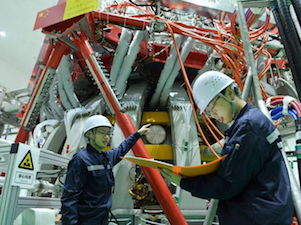According to China National Nuclear Corporation (CNNC), the HL-2M Tokamak apparatus is able to operate at 150 million degrees Celsius – almost three times hotter than the previous version called HL-2A.
The ability to generate such ultra-high temperature is essential for the research of fusion process, replicating the way the sun produces energy using hydrogen and deuterium gases as fuels. The sun only operates at a temperature of 15 million degrees Celsius.
The International Thermonuclear Experimental Reactor (ITER), which is under construction in southern France, is designed also to operate at up to 150 million degrees Celsius (270 million Fahrenheit).
The Korea Institute of Fusion Energy announced about a week ago that its reactor had succeeded in operating at 100 million degree Celsius for at least 20 seconds.
Yang Qingwei, chief engineer of CNNC’s Institute of Fusion Science at the Southwest Institute of Physics, was quoted by Xinhua on Friday as saying that HL-2M can achieve magnetic plasma confinement time of up to 10 seconds.
“HL-2M is China’s largest artificial sun with the best parameters,” Xu Min, director of the institute, was quoted as saying.
The new facility also has three times the plasma volume and six times the plasma current intensity compared with HL-2A, and that will substantially improve the research and development of fusion generator technology in China, according to a statement by CNNC, which oversees the project.
Yang said the project would become “an important pillar” to ITER, of which China is a member along with the United States, India, Japan, Russia and South Korea.
China’s HL-2M nuclear fusion device is displayed at a research laboratory in Chengdu, Sichuan province.
China aims to develop its fusion technology as it plans to build an experimental reactor as early as next year, build an industrial prototype by 2035 and go into large-scale commercial use by 2050.


